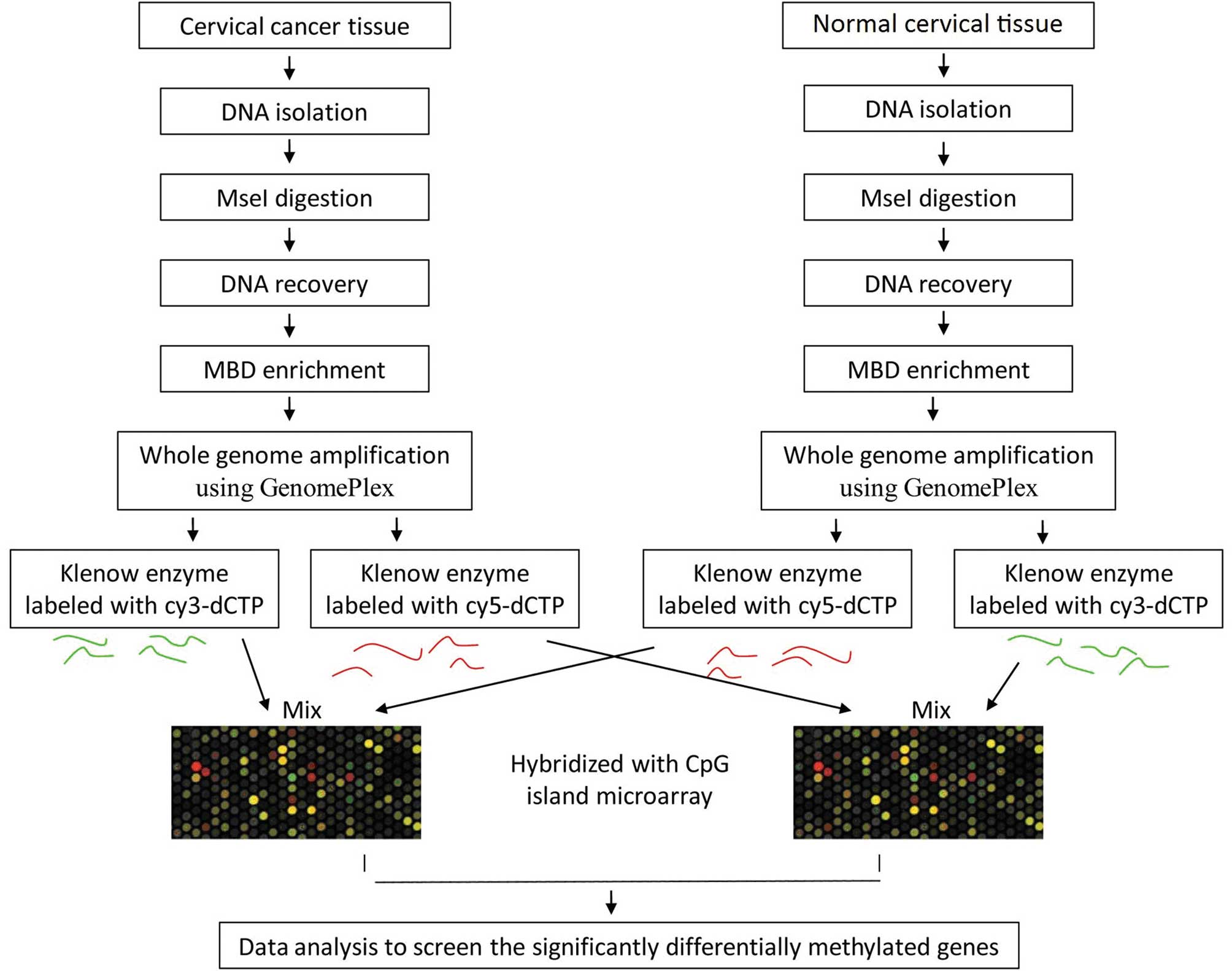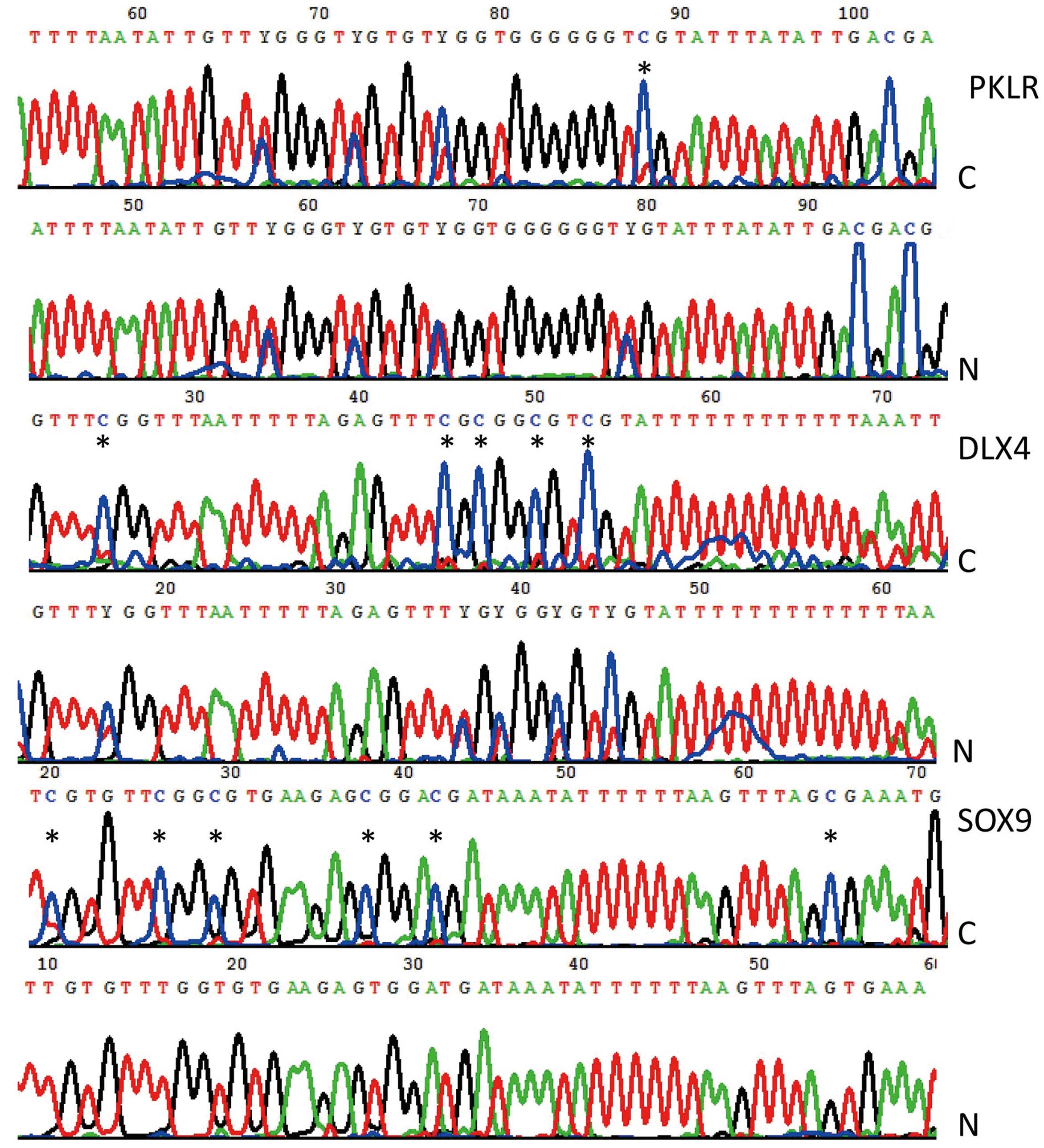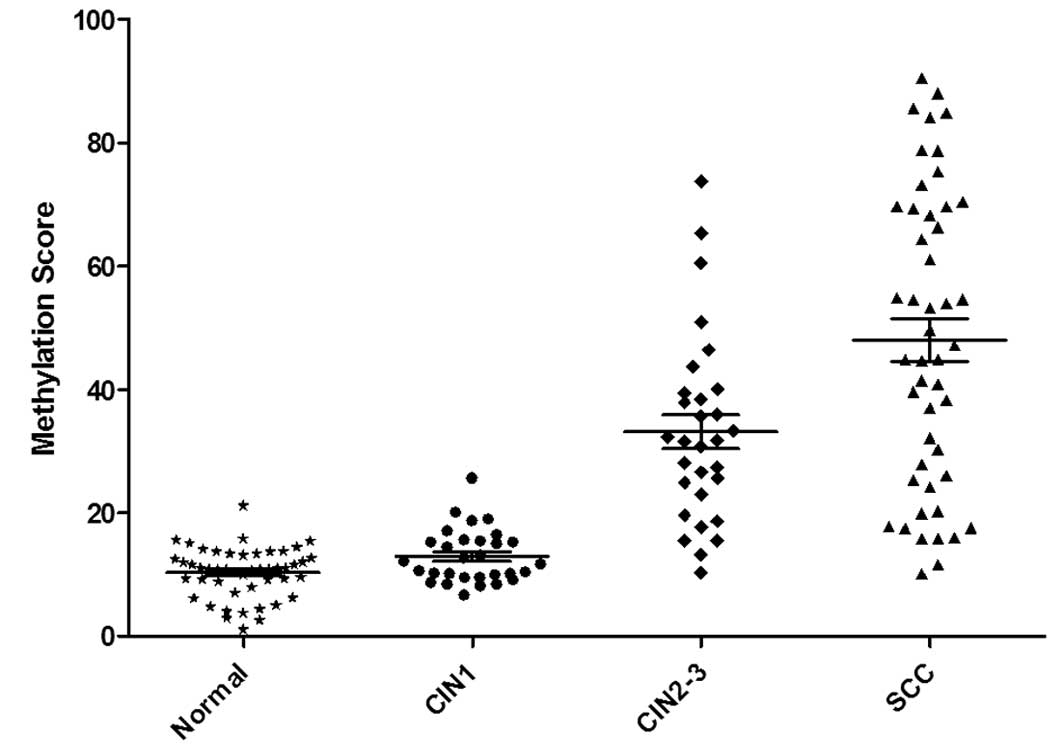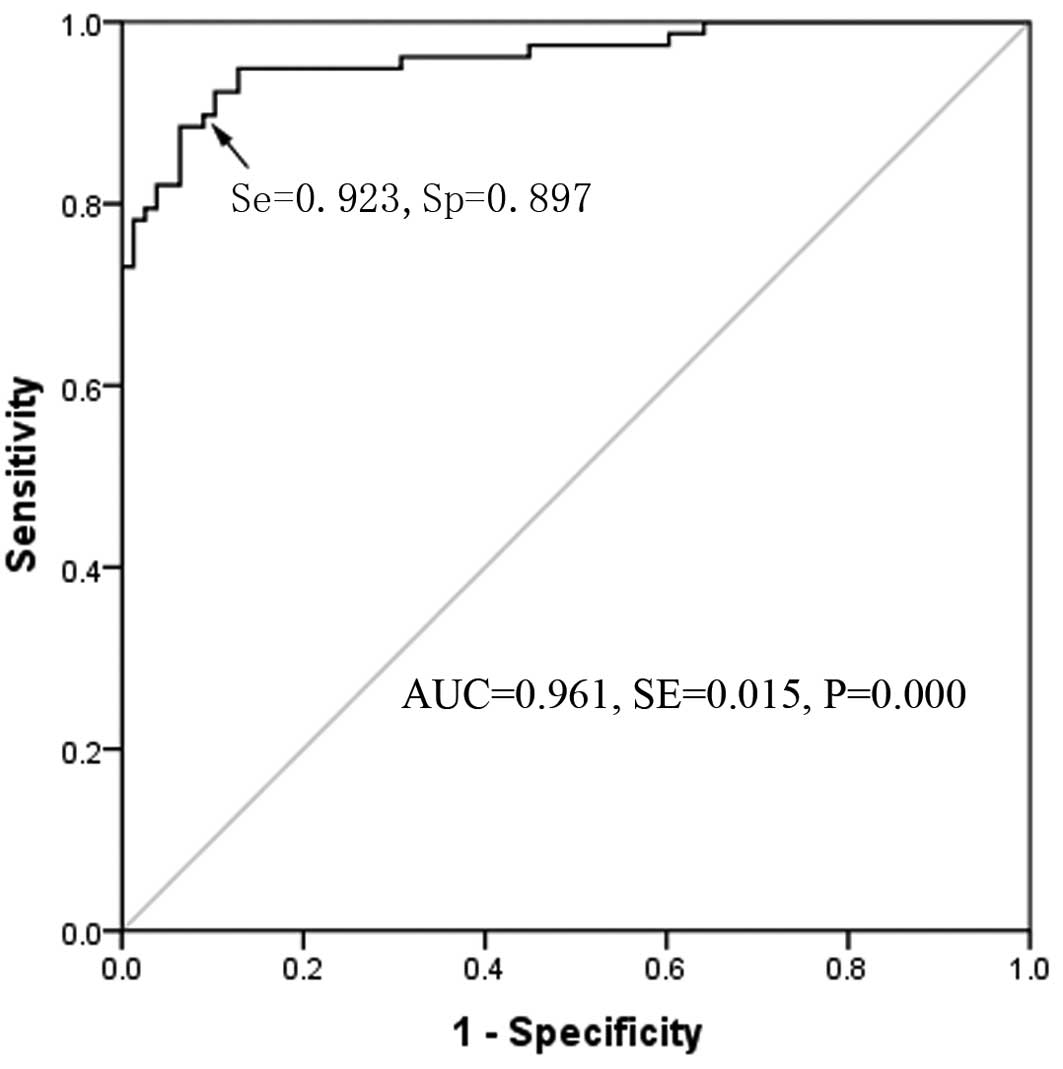|
1
|
Parkin DM, Pisani P and Ferlay J:
Estimates of the worldwide incidence of 25 major cancers in 1990.
Int J Cancer. 80:827–841. 1999. View Article : Google Scholar : PubMed/NCBI
|
|
2
|
Kamangar F, Dores GM and Anderson WF:
Patterns of cancer incidence, mortality, and prevalence across five
continents: defining priorities to reduce cancer disparities in
different geographic regions of the world. J Clin Oncol.
24:2137–2150. 2006. View Article : Google Scholar
|
|
3
|
Arbyn M, Bergeron C, Klinkhamer P,
Martin-Hirsch P, Siebers AG and Bulten J: Liquid compared with
conventional cervical cytology: a systematic review and
meta-analysis. Obstet Gynecol. 111:167–177. 2008. View Article : Google Scholar : PubMed/NCBI
|
|
4
|
Mayrand MH, Duarte-Franco E, Rodrigues I,
et al: Human papillomavirus DNA versus Papanicolaou screening tests
for cervical cancer. N Engl J Med. 357:1579–1588. 2007. View Article : Google Scholar : PubMed/NCBI
|
|
5
|
Cuzick J, Szarewski A, Cubie H, et al:
Management of women who test positive for high-risk types of human
papillomavirus: the HART study. Lancet. 362:1871–1876. 2003.
View Article : Google Scholar : PubMed/NCBI
|
|
6
|
Wright TJ, Massad LS, Dunton CJ, Spitzer
M, Wilkinson EJ and Solomon D: 2006 consensus guidelines for the
management of women with cervical intraepithelial neoplasia or
adenocarcinoma in situ. Am J Obstet Gynecol. 197:340–345. 2007.
View Article : Google Scholar
|
|
7
|
Castle PE, Schiffman M, Wheeler CM and
Solomon D: Evidence for frequent regression of cervical
intraepithelial neoplasia-grade 2. Obstet Gynecol. 113:18–25. 2009.
View Article : Google Scholar : PubMed/NCBI
|
|
8
|
McCredie MR, Sharples KJ, Paul C, et al:
Natural history of cervical neoplasia and risk of invasive cancer
in women with cervical intraepithelial neoplasia 3: a retrospective
cohort study. Lancet Oncol. 9:425–434. 2008. View Article : Google Scholar : PubMed/NCBI
|
|
9
|
Pretorius RG, Peterson P, Azizi F and
Burchette RJ: Subsequent risk and presentation of cervical
intraepithelial neoplasia (CIN) 3 or cancer after a colposcopic
diagnosis of CIN 1 or less. Am J Obstet Gynecol. 195:1260–1265.
2006. View Article : Google Scholar : PubMed/NCBI
|
|
10
|
Esteller M, Corn PG, Baylin SB and Herman
JG: A gene hypermethylation profile of human cancer. Cancer Res.
61:3225–3229. 2001.PubMed/NCBI
|
|
11
|
Shivapurkar N, Sherman ME, Stastny V, et
al: Evaluation of candidate methylation markers to detect cervical
neoplasia. Gynecol Oncol. 107:549–553. 2007. View Article : Google Scholar : PubMed/NCBI
|
|
12
|
Wentzensen N, Sherman ME, Schiffman M and
Wang SS: Utility of methylation markers in cervical cancer early
detection: appraisal of the state-of-the-science. Gynecol Oncol.
112:293–299. 2009. View Article : Google Scholar : PubMed/NCBI
|
|
13
|
Iliopoulos D, Oikonomou P, Messinis I and
Tsezou A: Correlation of promoter hypermethylation in hTERT, DAPK
and MGMT genes with cervical oncogenesis progression. Oncol Rep.
22:199–204. 2009.PubMed/NCBI
|
|
14
|
Feng Q, Balasubramanian A, Hawes SE, et
al: Detection of hypermethylated genes in women with and without
cervical neoplasia. J Natl Cancer Inst. 97:273–282. 2005.
View Article : Google Scholar : PubMed/NCBI
|
|
15
|
Wisman GB, Nijhuis ER, Hoque MO, et al:
Assessment of gene promoter hypermethylation for detection of
cervical neoplasia. Int J Cancer. 119:1908–1914. 2006. View Article : Google Scholar : PubMed/NCBI
|
|
16
|
Jung S, Yi L, Jeong D, et al: The role of
ADCYAP1, adenylate cyclase activating polypeptide 1, as a
methylation biomarker for the early detection of cervical cancer.
Oncol Rep. 25:245–252. 2011.PubMed/NCBI
|
|
17
|
Lai HC, Lin YW, Huang TH, et al:
Identification of novel DNA methylation markers in cervical cancer.
Int J Cancer. 123:161–167. 2008. View Article : Google Scholar : PubMed/NCBI
|
|
18
|
Sova P, Feng Q, Geiss G, et al: Discovery
of novel methylation biomarkers in cervical carcinoma by global
demethylation and microarray analysis. Cancer Epidemiol Biomarkers
Prev. 15:114–123. 2006. View Article : Google Scholar : PubMed/NCBI
|
|
19
|
Wang SS, Smiraglia DJ, Wu YZ, et al:
Identification of novel methylation markers in cervical cancer
using restriction landmark genomic scanning. Cancer Res.
68:2489–2497. 2008. View Article : Google Scholar : PubMed/NCBI
|
|
20
|
Rauch TA and Pfeifer GP: The MIRA method
for DNA methylation analysis. Methods Mol Biol. 507:65–75. 2009.
View Article : Google Scholar : PubMed/NCBI
|
|
21
|
Martens JW, Nimmrich I, Koenig T, et al:
Association of DNA methylation of phosphoserine aminotransferase
with response to endocrine therapy in patients with recurrent
breast cancer. Cancer Res. 65:4101–4117. 2005. View Article : Google Scholar : PubMed/NCBI
|
|
22
|
Huang TH, Lai HC, Liu HW, et al:
Quantitative analysis of methylation status of the PAX1 gene for
detection of cervical cancer. Int J Gynecol Cancer. 20:513–519.
2010. View Article : Google Scholar : PubMed/NCBI
|
|
23
|
Missaoui N, Hmissa S, Dante R and Frappart
L: Global DNA methylation in precancerous and cancerous lesions of
the uterine cervix. Asian Pac J Cancer Prev. 11:1741–1744.
2010.PubMed/NCBI
|
|
24
|
Nephew KP: What will it take to obtain DNA
methylation markers for early cervical cancer detection? Gynecol
Oncol. 112:291–292. 2009. View Article : Google Scholar : PubMed/NCBI
|
|
25
|
Apostolidou S, Hadwin R, Burnell M, et al:
DNA methylation analysis in liquid-based cytology for cervical
cancer screening. Int J Cancer. 125:2995–3002. 2009. View Article : Google Scholar : PubMed/NCBI
|
|
26
|
Kim JH, Choi YD, Lee JS, Lee JH, Nam JH
and Choi C: Assessment of DNA methylation for the detection of
cervical neoplasia in liquid-based cytology specimens. Gynecol
Oncol. 116:99–104. 2010. View Article : Google Scholar
|
|
27
|
Lim EH, Ng SL, Li JL, et al: Cervical
dysplasia: assessing methylation status (Methylight) of CCNA1,
DAPK1, HS3ST2, PAX1 and TFPI2 to improve diagnostic accuracy.
Gynecol Oncol. 119:225–231. 2010. View Article : Google Scholar : PubMed/NCBI
|
|
28
|
Eijsink JJ, Lendvai A, Deregowski V, et
al: A four-gene methylation marker panel as triage test in
high-risk human papillomavirus positive patients. Int J Cancer.
130:1861–1869. 2012. View Article : Google Scholar : PubMed/NCBI
|
|
29
|
Eijsink JJ, Yang N, Lendvai A, et al:
Detection of cervical neoplasia by DNA methylation analysis in
cervico-vaginal lavages, a feasibility study. Gynecol Oncol.
120:280–283. 2011. View Article : Google Scholar : PubMed/NCBI
|
|
30
|
Glockner SC, Dhir M, Yi JM, et al:
Methylation of TFPI2 in stool DNA: a potential novel biomarker for
the detection of colorectal cancer. Cancer Res. 69:4691–4699. 2009.
View Article : Google Scholar : PubMed/NCBI
|
|
31
|
Lefebvre V, Dumitriu B, Penzo-Mendez A,
Han Y and Pallavi B: Control of cell fate and differentiation by
Sry-related high-mobility-group box (Sox) transcription factors.
Int J Biochem Cell Biol. 39:2195–2214. 2007. View Article : Google Scholar : PubMed/NCBI
|
|
32
|
Kent J, Wheatley SC, Andrews JE, Sinclair
AH and Koopman P: A male-specific role for SOX9 in vertebrate sex
determination. Development. 122:2813–2822. 1996.PubMed/NCBI
|
|
33
|
Soderstrom M, Bohling T, Ekfors T,
Nelimarkka L, Aro HT and Vuorio E: Molecular profiling of human
chondrosarcomas for matrix production and cancer markers. Int J
Cancer. 100:144–151. 2002. View Article : Google Scholar : PubMed/NCBI
|
|
34
|
Stolt CC, Lommes P, Sock E, Chaboissier
MC, Schedl A and Wegner M: The Sox9 transcription factor determines
glial fate choice in the developing spinal cord. Genes Dev.
17:1677–1689. 2003. View Article : Google Scholar : PubMed/NCBI
|
|
35
|
Afonja O, Raaka BM, Huang A, et al: RAR
agonists stimulate SOX9 gene expression in breast cancer cell
lines: evidence for a role in retinoid-mediated growth inhibition.
Oncogene. 21:7850–7860. 2002. View Article : Google Scholar : PubMed/NCBI
|
|
36
|
Drivdahl R, Haugk KH, Sprenger CC, Nelson
PS, Tennant MK and Plymate SR: Suppression of growth and
tumorigenicity in the prostate tumor cell line M12 by
overexpression of the transcription factor SOX9. Oncogene.
23:4584–4593. 2004. View Article : Google Scholar : PubMed/NCBI
|
|
37
|
Enjuanes A, Fernandez V, Hernandez L, et
al: Identification of methylated genes associated with aggressive
clinicopathological features in mantle cell lymphoma. PLoS One.
6:e197362011. View Article : Google Scholar : PubMed/NCBI
|
|
38
|
Aleman A, Adrien L, Lopez-Serra L, et al:
Identification of DNA hypermethylation of SOX9 in association with
bladder cancer progression using CpG microarrays. Br J Cancer.
98:466–473. 2008. View Article : Google Scholar : PubMed/NCBI
|
|
39
|
Bennett LB, Schnabel JL, Kelchen JM, et
al: DNA hypermethylation accompanied by transcriptional repression
in follicular lymphoma. Genes Chromosomes Cancer. 48:828–841. 2009.
View Article : Google Scholar : PubMed/NCBI
|
|
40
|
Chakravarty G, Moroz K, Makridakis NM, et
al: Prognostic significance of cytoplasmic SOX9 in invasive ductal
carcinoma and metastatic breast cancer. Exp Biol Med. 236:145–155.
2011. View Article : Google Scholar : PubMed/NCBI
|
|
41
|
Sun M, Uozaki H, Hino R, et al: SOX9
expression and its methylation status in gastric cancer. Virchows
Arch. 460:271–279. 2012. View Article : Google Scholar : PubMed/NCBI
|
|
42
|
Wang KH, Liu HW, Lin SR, Ding DC and Chu
TY: Field methylation silencing of the protocadherin 10 gene in
cervical carcinogenesis as a potential specific diagnostic test
from cervical scrapings. Cancer Sci. 100:2175–2180. 2009.
View Article : Google Scholar : PubMed/NCBI
|


















